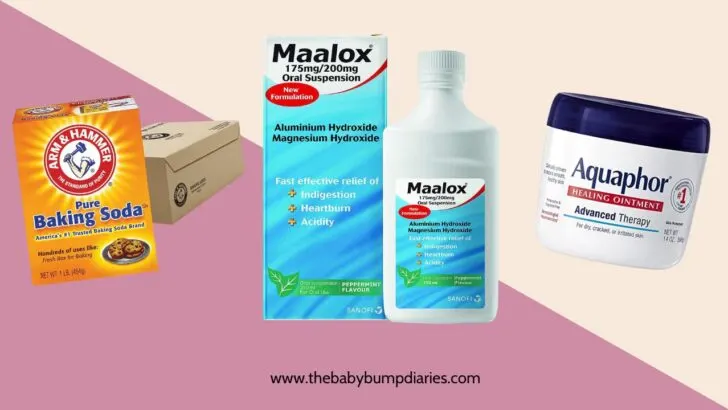I’m a mom of three kiddos under age 5, and I’ve dealt with my fair share of diaper rashes.
Most are pretty calm and can be treated with a little Aquaphor. But one time? It was so bad on my daughter that there were welts and broken skin.
I got the best advice from my pediatrician, and I haven’t seen it mentioned anywhere online. If you have a monstrous diaper rash that you need to kick in the butt, I have a magic trick for you!
Note: I am not a doctor – just a mom of three little ones. All of the advice in this article is information I have gleaned from our doctors and pediatricians over the years. It’s also the advice that actually helped my babies! But still, I’m not a doctor so please consult your physician for medical advice.
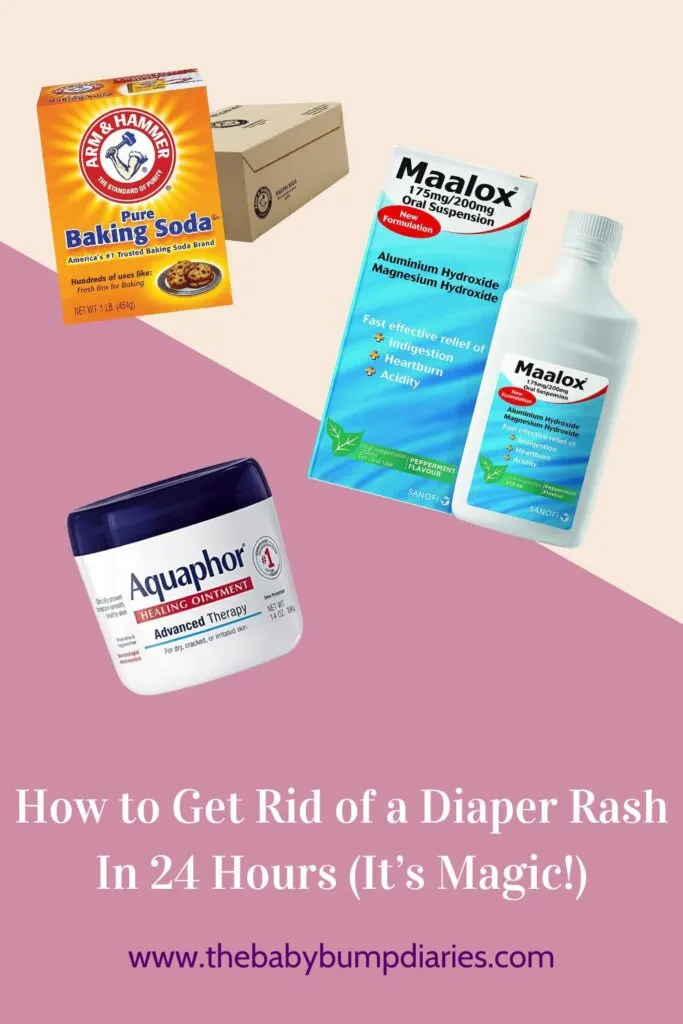
At-Home Remedies to Get Rid of Diaper Rash Fast
There are three at-home remedies that actually get rid of diaper rash in about 24 hours. I’ve personally used all three of these with amazing success – the first one is a magic trick!
1. Use an Antacid Liquid (Maalox)
I hardly believed my ears when my pediatrician advised purchasing an antacid liquid and applying it to our daughter’s diaper rash with a cotton round.
Like, an antacid drink?! Yep!
She specifically recommended Maalox, but we didn’t have that at our nearest drugstore, so we picked up a generic antacid liquid. It worked just as well!
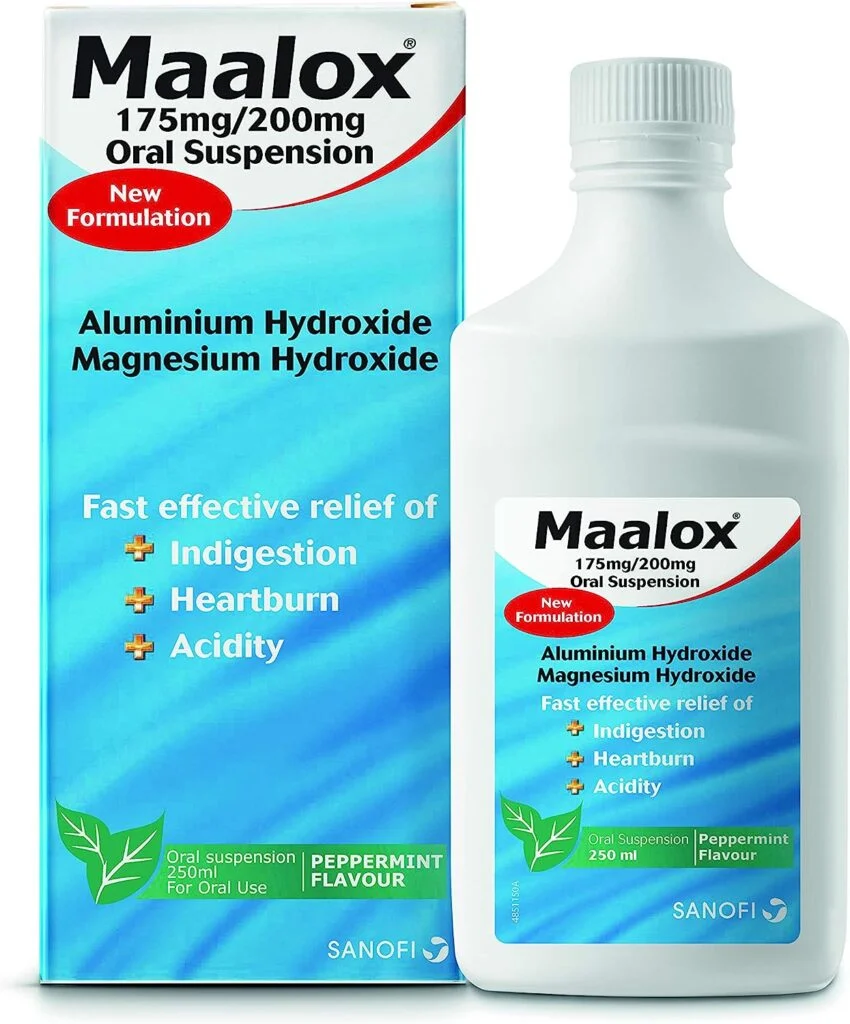
Our pediatrician said antacid liquid is a trick she and all the nurses use on babies in the NICU. It works so well and so fast, and it’s cheap.
Before using the antacid liquid, we had done everything possible, from diaper creams to airing it out to bath soaks. Nothing improved her sore, open wounds for days until we applied the antacid.
I kid you not, the diaper rash completely turned around in a matter of 24 hours.
I could stop the article right here because I think this is the best way to get rid of a diaper rash in 24 hours or less. But there are a few other at-home remedies worth mentioning.
Related Reading: 12 Life-Saving Tips for Preventing Diaper Blowouts Up the Back
2. Baking Soda Bath
Similar to Maalox, baking soda neutralizes acid. The alkaline pH neutralizes the acidity in that diaper rash, which can help it start to heal.
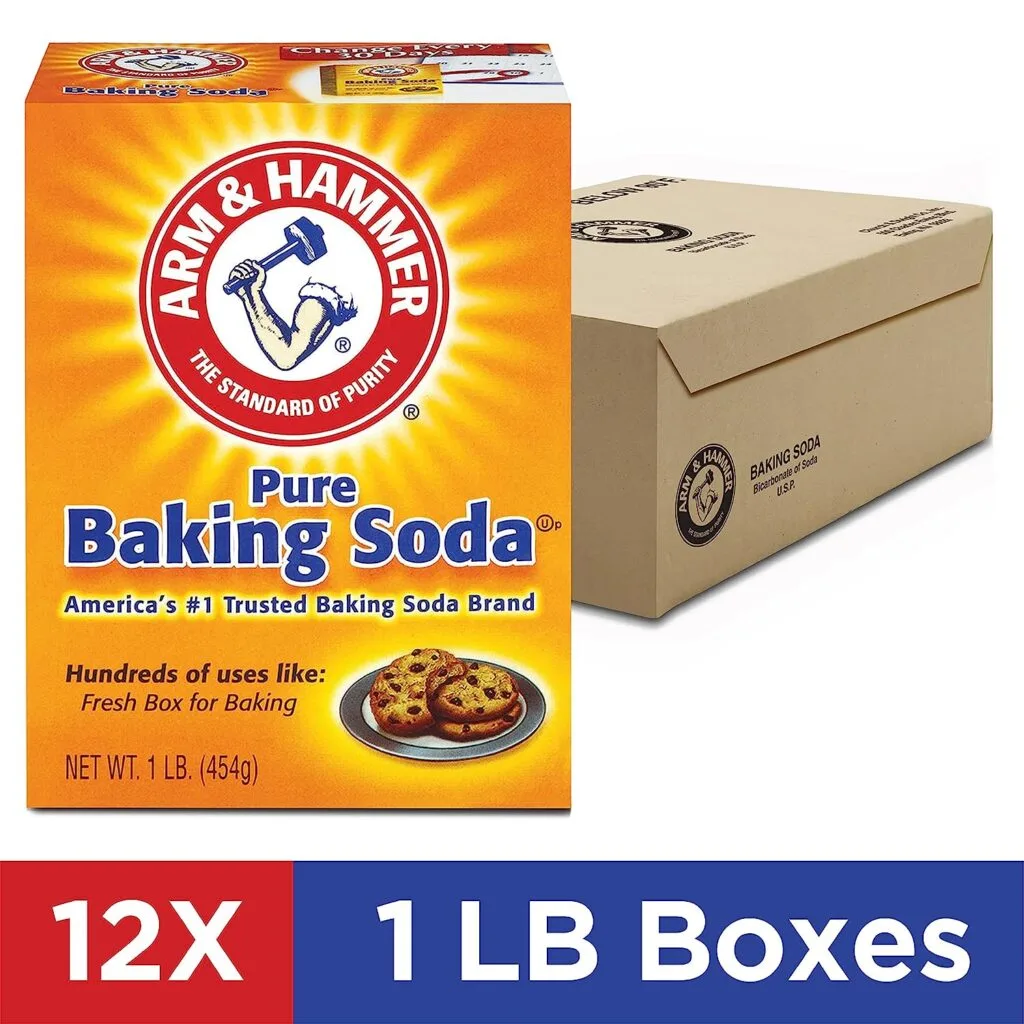
The best way to use baking soda to calm down a diaper rash is by adding it to a warm bath.
Add 1/4 cup of baking soda to a lukewarm bath and let your baby relax in there for half an hour. It will help relieve irritation and start to heal that diaper rash. In fact, you can do this in conjunction with the antacid liquid to speed up recovery.
A baking soda bath can also calm down other skin conditions like eczema and psoriasis. Our diaper rash daughter also had eczema on occasion, and the baking soda baths were a huge help in calming that down.
3. Aquaphor
For a raging diaper rash, I’d go straight for the antacid liquid and possibly even a baking soda bath on top of it.
But if you have a diaper rash that’s just forming and it’s not super angry yet, apply an appalling amount of Aquaphor. Like a huge glob. If you think it’s too much, it’s perfect.
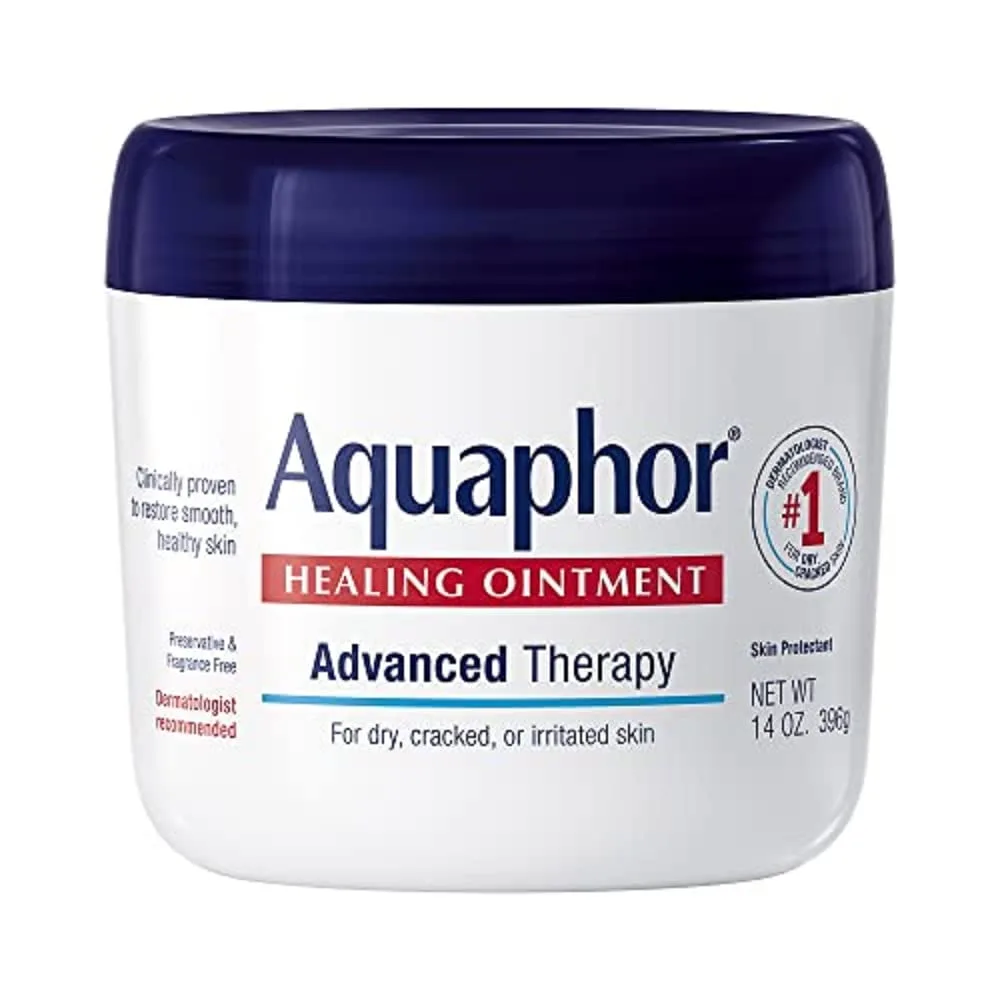
Our family went through all kinds of diaper rash creams, and Aquaphor was the only one that prevented diaper rashes and helped them go away.
Aquaphor contains petrolatum, which is an occlusive moisturizer. When applied, it forms a water-repellant film on the skin. This barrier on the skin seals in moisture, preventing transepidermal water loss (TEWL).
Essentially, Aquaphor stops the skin from drying out and seals it off from other contaminants (like baby poop!). If your baby’s poop is particularly acidic, applying Aquaphor at each diaper change can be particularly helpful in preventing diaper rash.
Related: Pull-Ups vs Diapers: Differences + When to Switch
Consult See Your Pediatrician
Diaper rashes happen for various reasons, from skin irritants to yeast infections to bacterial infections. Sometimes, the only way to truly get rid of that diaper rash might be a medicated cream.
So, if at-home remedies like the ones I mentioned in this article don’t help, definitely take that baby to the doctor for help. And if your baby has a fever in addition to a diaper rash, go to the pediatrician right away.
The following options might be treatments your pediatrician will recommend.
1. Antifungal Cream
If the diaper rash is due to yeast, it’ll typically look bumpy – almost like pimples. And in these cases, the best treatment will be an antifungal cream.
The two creams we’ve used over the years with success are nystatin and clotrimazole. Your pediatrician will send in a prescription for a medicated cream.
Please note that if your baby’s diaper rash is from yeast, regular Aquaphor or diaper cream isn’t going to help. You need an antifungal to kill off the yeast and reduce the growth of fungi.
So, if you try some of the at-home remedies mentioned on this list and nothing is working, it may be a sign that the diaper rash is a yeast infection.
2. Antibiotic Ointment
If bacteria caused the diaper rash, called impetigo, you definitely need a doctor to intervene.
In these cases, the diaper rash has bright red skin around the anus, and you may also notice yellow crusting or pimples. The type of bacteria will alter how the infection presents itself, but you’ll know you need a doctor when regular diaper creams like Aquaphor don’t help.
Your physician would likely prescribe mupirocin or bacitracin ointment to eliminate the bacterial infection.
Tips on Preventing Diaper Rashes
If your baby has a raging diaper rash, definitely try the at-home remedies and then consult your doctor if nothing is working.
However, if you’ve just gotten over a diaper rash or want to actively prevent it from happening in the future, I have some tips!
1. Apply Aquaphor at each diaper change.
If your baby is particularly prone to diaper rashes, I’d recommend proactively applying Aquaphor to their booty at each and every diaper change.
It’ll shield their rear and keep it moisturized.
2. Change diapers more frequently.
Some babies have more sensitive skin than others. And if your baby is particularly sensitive, you may have to change their diaper more frequently.
A diaper with a line indicator can be a big help here as it’ll change colors when it’s wet and needs to be changed.
3. Use fragrance-free wipes (not unscented!).
A common irritant for babies can be fragrances in baby wipes.
I’d highly recommend getting fragrance-free wipes or wipes that are almost entirely water.
Related: Do Baby Wipes Expire? How Long Is the Shelf Life?
My favorite baby wipes are from Coterie. They’re 99% water and have no fragrance added. They’re also larger and thicker than most wipes, which makes the entire changing experience so much better.
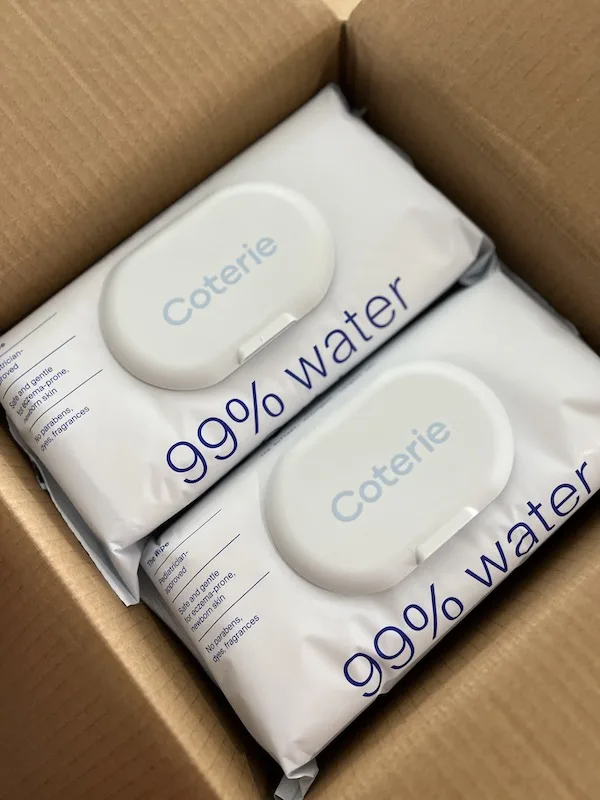
Take care to avoid products labeled “unscented.” Unscented means the product contains masking chemicals that cover up the odor of other ingredients.
Fragrance-free means there are truly no masking scents or fragrance materials used in the wipes.
Related: How Many Baby Wipes Do I Need per Day, Month, & Year?
4. Go commando on occasion.
Every now and again, take your babe’s diaper off and let them air out a bit.
They spend almost all of their little lives with a diaper on – a little break can help keep the area in tip-top shape.
A Note on Acidic Baby Poop and Breastfeeding Moms
If your baby continually gets diaper rashes and you’re breastfeeding, there’s a good chance it’s because the baby’s poop is extra acidic from too much foremilk.
Stick with me here.
Acidic baby poop is often a result of lactose overload. Lactose overload can happen when your baby is consuming more foremilk than hindmilk. Foremilk has less fat and is the milk your baby gets at the beginning of a feed.
If you produce a ton of milk and switch your baby from one breast to the other relatively quickly, they aren’t getting a lot of hindmilk, or the extra fatty milk toward the end of a feed.
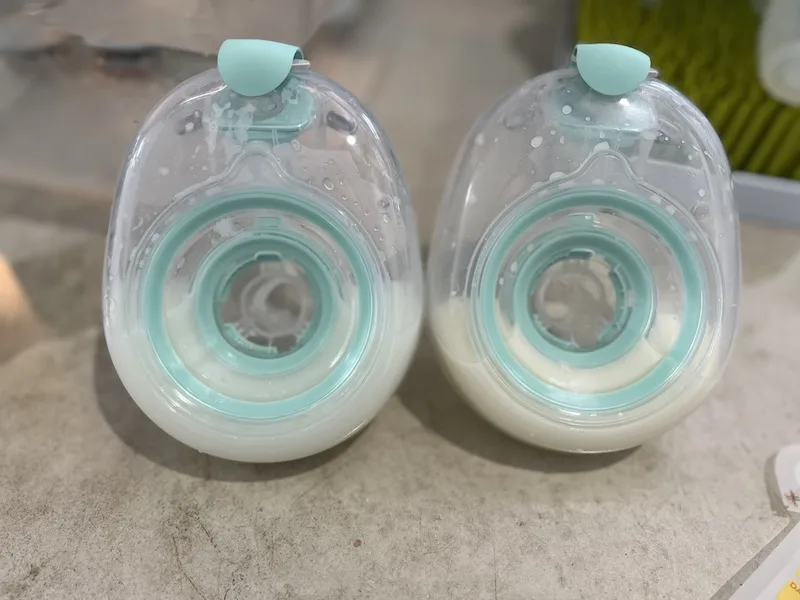
This overload of foremilk moves through the body too fast for the lactose to break down, which can lead to tummy pains, acidic poop, and, eventually, diaper rashes (Australian Breastfeeding Association).
So, if you’re wanting to get down to the cause of recurrent diaper rashes, definitely consider keeping your baby on your breast for a full feed to ensure they get foremilk and hindmilk. It just might work!
Conclusion
The moral of the story here is to try an antacid liquid like Maalox on a cotton round to turn around that gnarly diaper rash. If you try this, please leave a comment and let me know how it went!
Further Reading:
Rebekah is a writer and mother of three young children. She is also the woman behind Two Mama Bears, a blog for parents with babies and toddlers.

